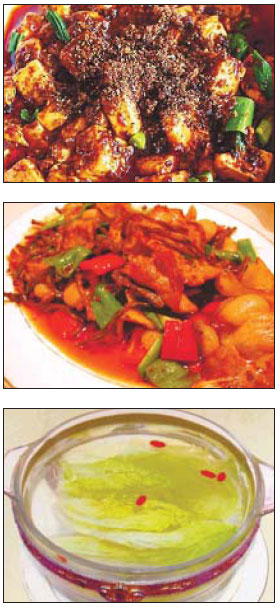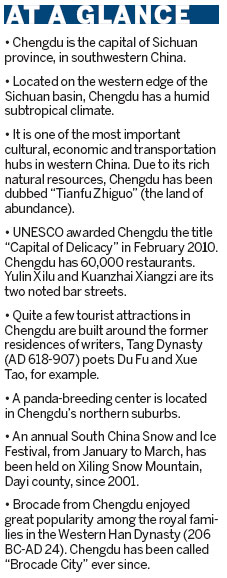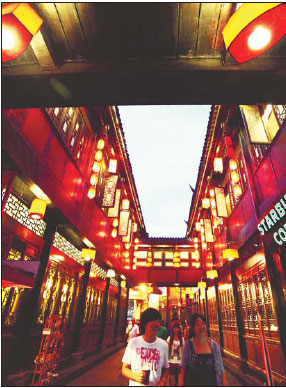Share Your Experience
Fired up for the day
Updated: 2011-01-13 08:09
By Chitralekha Basu and Guo Shuhan (China Daily)
Sichuan cuisine has undergone a sea change, quite literally, since China's opening up in 1978. An abundance of seafood appeared after the ban on imports was lifted.
"Even domestic kitchens are using beef flown in from Australia," Shi adds.
|
Visitors enjoy Chengdu's bustling night life in Jinli, a street known for a variety of souvenir stores and snacks. Niu Shupei / For China Daily |
"In the first years of China's economic reforms, Chengdu had about 30 decent restaurants, now there are 60,000 in a city with a population of 11 million," says Li, who presides over the Sichuan Gastronome Association. "In the past, high officials, eminent personalities and business people formed the clientele. Now, ordinary people with rising incomes like to explore the food scene as well."
Li Hongwei, 35, who is the executive chef with Shangxi restaurant on Chengdu's posh Kuanzhai Xiangzi, says chefs today "are required to keep a keener eye on quality control than before even as they enhance their professional abilities and cultural understanding of food". As clients become more aware and discerning, one has to be more cautious about "the authenticity of the ingredients used".
Li Hongwei spends lots of time reading related books and watching videos and makes it a point to look for the cultural context leading to the evolution of a dish he might be preparing in its present form.
 |
Both Li Shuren and master chef-turned-food writer Peng Ziyu, 65, who prepared a banquet menu for former French president Jacque Chirac and former Australian prime minister Kevin Rudd, believe innovation is the key for any cuisine tradition to sustain itself.
When Peng served Chirac in 2004, he toned down the spiciness of mapo tofu, having been informed of the French president's tastes. Peng was awarded the Masters of Sichuan Cuisine accolade when he shredded and fried a Chinese watermelon worth 2 yuan (30 cents) to resemble 12 chrysanthemums. "Nobody could tell what went into the making of a dish that looked so classy and sophisticated," Peng chuckles.
He is totally in favor of incorporating Western methods that change the molecular composition of foods by using chemical or physical methods.
 |
"This method has the advantage of sustaining the nutrients, and is an effective way of coming up with substitute food for people with special requirements. A patient forbidden to have egg yolk can have a substitute made from mango, for instance," he says.
"Sichuan cuisine is the most widely-consumed among the Chinese cooking styles worldwide, with 3,000 basic dish types and 20 basic flavors. Most Chinese restaurants, the world over, serve Sichuan-style food," Shi Guanghua says. "No matter where you come from and whatever your age and gender, you will find a dish of Sichuan cuisine that matches your tastes."
A 2006 statistic shows there are some 9,000 restaurants serving Chinese cuisine in Britain, 2,200 in Holland and more than 7,000 across Germany. A program co-produced by Love Radio of Chengdu Broadcasting Station and the BBC, first aired in 2004, with the aim of introducing cuisine to a Western audience by engaging in light chitchat, and is still a favorite.
What's probably needed is a more concerted effort to further the cause of Sichuan food. There are still a few stumbling blocks between this widely admired cuisine style and it making a big splash in the international arena, feels Mai Jianling, vice-president of Sichuan Gastronome Association, which is dedicated to popularizing Sichuan cuisine across China and beyond.
While food and wine companies with substantial credentials are trying to get into the business of running Chinese restaurants abroad, their efforts are often thwarted by local regulations on food safety, the nitty-gritty of the legal procedures involved in setting up a restaurant and inadequate market research.
The Sichuan Gastronome Association, which has a tie-up with the Overseas Chinese Union, sent four chefs to Brazil and Venezuela in 2009 to help Chinese-origin residents wishing to start a restaurant business get a grasp on Sichuan cuisine.
"Besides having a dedicated organization which helps connect people wishing to take Sichuan cuisine abroad and the corporate and catering associations there, we also need a comprehensive market survey in order to form a business strategy," Mai says.
To catch on in Western cultures Sichuan cuisine also needs to achieve standardization in terms of the presentation of a particular dish. "But the chefs here want to retain their individual touch and are constantly innovating," Mai says.
Apparently, innovation is not always a blessing.
Specials

President Hu visits the US
President Hu Jintao is on a state visit to the US from Jan 18 to 21.

Ancient life
The discovery of the fossile of a female pterosaur nicknamed as Mrs T and her un-laid egg are shedding new light on ancient mysteries.

Economic Figures
China's GDP growth jumped 10.3 percent year-on-year in 2010, boosted by a faster-than-expected 9.8 percent expansion in the fourth quarter.
